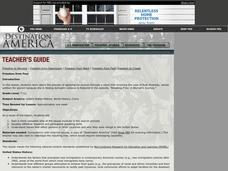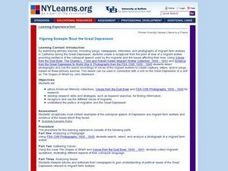Curated OER
Exploring a New World
Fifth graders create a PowerPoint presentation about Christopher Columbus. The integration of technology helps them to be engaged in the subject matter. The basis for the information in the presentation is for students to answer some...
Curated OER
American Migrations Timeline
In order to answer the question of whether the United States is a country of migrants or immigrants, students compile a list of migrations in America. From this list they conduct individual research for a particular episode of migration...
Curated OER
Lesson Plan on Migration
Fourth graders diagram written and oral directions of a Native American, European Viking, Right Whale or Humpback Whale migration route, the student diagram all directions only in the sequence given, with arrows indicating direction of...
Curated OER
Hopscotch Migration
Students examine the use of wetlands by migrating birds. They discuss reasons for the disappearance of wetlands. They discover how humans have affected wetlands as well.
Curated OER
To Come to Illinois - Or Not?
Students analyze primary documents to determine whether the author is pro- or anti-emigration. They outline reasons for or against immigration to Illinois during the early 19th century.
Curated OER
Boombox Classroom: Migration of Music
In this music worksheet, students complete two multiple choice questions about music moving from one culture to another. They write a sentence explaining why slavery is wrong. Students name types of music African-Americans brought with...
Curated OER
America's Civil Rights Movement, Activity Seven
Students model the writing style of the author of a piece of literature and present them to the class.
Curated OER
America's Civil Rights Movement, Activity Ten
Young scholars identify a wrong in their own community and act to correct it. They reflect on the intersection fo the Civil Rights Movemnet with a social justice project.
Curated OER
National expansion of the United States (1815 to 1850), and its connection to local Illinois history.
Students discuss the importance of establishing the I & M Canal water route. They watch a video about the canal's history. They collect and write a personal migration story by interviewing a family member. They analyze trends and...
Curated OER
Introduction to a Unit on the 1930's Depression in America
Learners view and discuss photographic images of the Dust Bowl by Dorothea Lange. They discuss who Dorothea Lange was and why she took the pictures, the conservational factors that contributed to the Dust Bowl and migrant workers and the...
Curated OER
Freedom to Worship
Young scholars investigate reasons why people sought freedom to worship in the United States and some of the difficulties and issues facing them in their immigration. As immigrants, they write letters to family members in the old country.
Curated OER
Coming to Nova Scotia
Students discover the definition of a Pioneer, when the largest groups of people of African descent came to Nova Scotia, and what materials and resources were brought with them to establish a new life.
Curated OER
East to West: Africa's Influence on Mexico
Your historians and social anthropologists study the relationship between peoples of ancient Africa and ancient Mesoamerica. They relate in written or verbal form the African presence in the ancient Americas. They create their own...
Curated OER
People on the Move
Students explore transportation. In this transportation lesson, students examine the Jupiter locomotive, Washingtion D.C. streetcars, the Leviathan, the Salisbury Train Station, and Route 66. Students respond to 12 questions.
Curated OER
The Earliest Americans
The topic of the peopling of the Americas offers the opportunity for a fascinating discussion. Give your class the knowledge they need to understand the migration across Beringia, the hunter-gatherer lifestyle, and the impact of...
Curated OER
Panama Canal
Learners investigate a way to sail a boat around the world without touching land while learning about the Panama Canal. In this Panama Canal lesson plan, students learn about the relationship of socio-political continents and how the...
Smithsonian Institution
Watching Crystals Grow
Amazing science can sometimes happen right before your eyes! The class gets cozy as they watch crystals grow. They use Epsom salts, rocks, and food coloring to create crystals. They'll observe the entire process, documenting every step...
Curated OER
Figuring Somepin 'Bout the Great Depression
Students conduct research from primary and secondary resources in order to help with comprehension of the time period of The Great Depression in American History. The examination of literature is also used in this instructional activity.
Curated OER
Here Today. . .Gone Tomorrow
Students observe that there are threatened and endangered bird species in Illinois, why they have been given this status and how it relates to endangered species on a worldwide basis. they participate in the Project WILD "Oh, Deer" or...
Curated OER
Latin American Film
Students explore the Latin American film industry. In this Latin American film lesson, students compare Latin American films to American films as they watch segments of "Que Viva Mexico!" Students research the painters on the film and...
Curated OER
On the Trail of the Hudson's Migratory Fish
Using data related to the fish in the Hudson River area, learners calculate distance, elapsed time, and growth. They learn about migratory fish, the life cycle of a fish, analyze a map, and answer questions.
Curated OER
Prairie Voices: German Immigrants Move to Iowa
Students create historically accurate travel journals. In this Iowa history lesson, students research the German immigration experience as they write travel journals that feature a German family's move into an Iowa county.
Curated OER
Immigration: A History
Studnets trace how immigration patterns have changed in America's history. They analyze the relationship between economic growth and immigration.
Curated OER
The Early Peoples
Students, after studying The Early Peoples, explain and give examples of how Native Americans and Europeans adapted to living in certain environments. They give examples of early cultures and settlements that existed in North America...

























